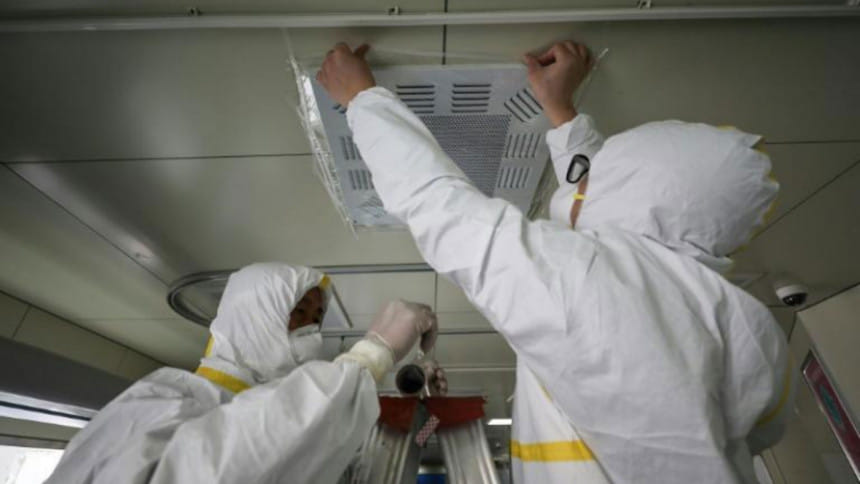Airborne transmissions could be the next new battle

The latest report in The Lancet, one of the most well-known international medical journals, on how Covid-19 spreads, is a real shocker. It challenges many of the measures countries are taking to stop the spread of infections. Now it's not just people sneezing or coughing without masks and thus throwing virus-carrying droplets on surfaces that should worry us, but whether someone carrying the virus including the asymptomatic, has been exhaling, speaking, singing or shouting in a closed space that you happen to walk into. The Lancet report by six experts, says that there is ample evidence to suggest that the SARS Cov 2 is an airborne pathogen that could stay infectious in the atmosphere as aerosols for up to three hours since emission from a carrier. The report's writers have said that 33 percent to 59 percent of all coronavirus cases can be attributed to the asymptomatic or pre-symptomatic transmission without the infected person coughing or sneezing (Business Today, India, April 23).
There is worse news. The pathogen has been detected in air filters and building ducts in hospitals with Covid-19 patients in them which corroborates the aerosol theory.
The writers of the report say this could explain the unprecedented spread of infections in many apparently "controlled" situations—such as persons quarantining in hotels in adjacent rooms getting infected without even meeting each other. The report findings include cases of hospital staff becoming infected despite wearing PPE and all other protective gear that should protect them from pathogen containing droplets. Because it's in the air! And it is spreading faster indoors than outdoors according to this report.
This horrifying scenario that was being speculated by researchers as far back as last year and that the world decided to ignore, could change the way we are trying to stay safe. The writers of the report—scientists from the US, UK and Canada say that indoor transmissions are more common especially in poorly ventilated areas. They suggest opening the windows and making sure indoor spaces are well ventilated, going outside as much as possible—getting some sun and fresh air.
One cannot help but think of the tiny back to back rooms in our slums inhabited by whole families, the hostels for students and working professionals, many apartment buildings, even offices where windows cannot be opened—all potential welcoming hosts to the virus.
The Lancet Covid-19 Commission's India Task Force, while not supporting blanket lockdowns, has recommended a two month ban on all indoor public gatherings to break the chain of transmission. India is seeing an unprecedented surge in infections and deaths with daily infection rates over 3 lakhs and daily deaths over 2,000 on April 22. The Task Force has attributed the surge to mass gatherings such as religious festivals, political events like the state elections, weddings and sport events (India Today, April 17). The Commission has recommended a ban on indoor gatherings larger than 10 people, a closure of cinemas and stadiums.
So what about us?
For a city with 21.7 million people—this latest explanation for the speed of transmission points to just how precariously we exist because we have allowed such untenable population densities in our cities. There are just too many people everywhere—inside and outside. Which is why it is so difficult to enforce health protocols like social distancing. As we have seen, despite the strong directives for public transport to keep spaces between passenger seats, it has been virtually impossible to maintain, because there are too many people waiting for too few vehicles—and they have to go to work to feed themselves. So they rush in, shoving aside any attempts to keep them out. The same is true for indoor kitchen markets that have poor ventilation and are usually teeming with people. In those situations, wearing masks seems the only doable precautionary measure which still exposes people to airborne transmission.
The government has imposed lockdowns which may stop some people from crowding the streets, but will it stop the spread indoors? How many people have windows to open? Where is the fresh air? How can we go outside to open spaces? There are no open spaces in Dhaka only spaces filled with people.
Now that the government has announced that shops and malls are allowed to open from today, what is going to happen if people rush in for Eid shopping?
Thus, yet again we see how complex the fight against the virus is proving with economic survival and hunger on one side and death from the virus on the other.
So what can we realistically do?
Since SARS Cov 2 and its innumerable variants will continue to ravage humankind the only thing we can do is listen to the science and try our best to follow its advice. The primary line of defence against this invisible enemy is the body's own defence system. Thus building the body's immunity should be the number one priority. Doctors recommend eating freshly cooked food as opposed to processed food that contain high levels of preservatives and are low on nutrition and anti-oxidants. Losing excess weight is also beneficial as individuals who are overweight or obese are at risk of developing severe conditions if infected. We need regular exercise at least 30 minutes of it, say doctors, seven to eight hours of sleep, some sun exposure if possible and consume Vitamin C and D rich foods or failing that, supplements to boost immunity. Such guidelines, need to be made more public and not restricted to the privileged sections.
The conclusion of the Lancet report, that the pathogen could be airborne, demands that policymakers take urgent steps. In addition to getting more ICU beds and central oxygen supply systems in public hospitals which are acutely inadequate or non-existent—proper ventilation systems have to be installed (systems used in hospitals in other countries can be used as models) and existing air ducts and vents have to be regularly cleaned, filters replaced and touch points sanitised. Private hospitals that actually have the money to do this have to invest in cleaning up the air ducts and vents. This applies to shopping malls, hotels and office buildings.
As vaccines seem to be another important protective measure despite some reservations regarding their efficacy in fighting new variants, the desired goal of 70 percent of the population being vaccinated has to be achieved within the stipulated time—by making registration accessible to everyone. This means sourcing the vaccine from other countries (that will actually deliver on their commitments) as well as getting the formula to manufacture locally—both of which seem to be underway but should have been started many months ago. Testing and contact tracing has to be ramped up drastically to get the real picture and to isolate and treat if necessary, those who are positive and prevent them from spreading the infection. This requires testing to be affordable if not free for low-income groups.
There has to be more investment in research to find out more about the pathogen that is constantly mutating. We have dedicated scientists and graduates who are already researching the virus—these are the people who need to be supported by government and private enterprises. We also need more data on why there is less spread of the virus (till now) in the villages—could it be because people are mostly outside and also get a lot of sun exposure? Or because they are physically active and eat little but fresh food? All this requires a dramatic increase in the government's health budget as well as its commitment to combat the virus rationally and with foresight.
The Lancet report has given the challenge of fighting this battle a new spin—one that has revealed the added vulnerabilities of our hospitals, offices, homes and other indoor spaces in our crowded cities. It also reiterates the cost of large gatherings especially in indoor settings that must be stopped for now. We must devote all our energies and resources to reduce these vulnerabilities in order to fight a virus that seems to be viciously outwitting every new effort to contain it.
Aasha Mehreen Amin is Head of Editorial and Opinion, Senior Deputy Editor, The Daily Star.

 For all latest news, follow The Daily Star's Google News channel.
For all latest news, follow The Daily Star's Google News channel. 



Comments